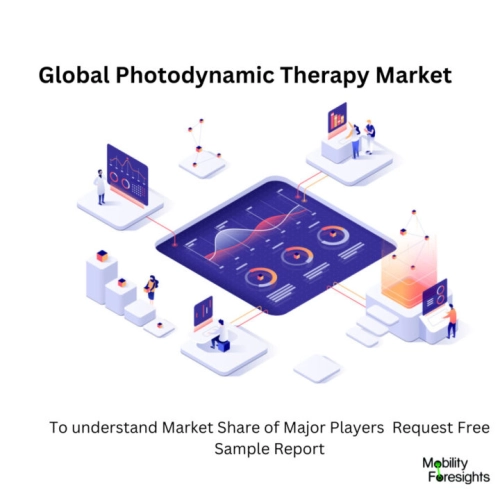
- Get in Touch with Us

Last Updated: Apr 25, 2025 | Study Period: 2024-2030
Photodynamic therapy (PDT) is a medical treatment that targets and treats a variety of medical disorders, including certain types of cancer, skin conditions, and eye diseases, by combining light with a photosensitizing chemical. PDT is based on the idea that when particular photosensitizing chemicals are exposed to precise wavelengths of light, they become activated, resulting in the destruction of targeted cells or tissues.
This treatment is less intrusive than typical surgical techniques and can address both surface and localized problems. The patient is given a photosensitizing agent. Depending on the illness being treated, this drug can be administered orally, intravenously, or topically. At this point, the photosensitizer is usually inactive. This accumulating process can take anything from a few hours to a few days.
Lasers or specialized light sources can be used to deliver this light. PDT is used to treat skin cancer (basal cell carcinoma and squamous cell carcinoma), as well as some forms of lung cancer, esophageal cancer, and head and neck cancers. It is frequently used to treat early-stage cancers and lesions. Although photodynamic therapy is typically regarded as a minimally intrusive treatment option, it can cause skin irritation, redness, edema, and temporary light sensitivity.
Depending on the medical condition being treated, the specific treatment regimen, including the type of photosensitizer, light source, and treatment time, differs. Patients should speak with a medical expert to evaluate whether PDT is an appropriate therapy choice for their unique circumstance.

The Global photodynamic therapy market accounted for $XX Billion in 2023 and is anticipated to reach $XX Billion by 2030, registering a CAGR of XX% from 2024 to 2030.
Photodynamic treatment is a revolutionary method of killing cancer using light. PDT employs light (often given by a laser), a light-sensitive medication, and molecular oxygen to initiate a series of cascade processes that result in the production of a cytotoxic chemical, singlet oxygen, which kills cancer cells.
PDT treatment comes in several forms, including external beam or surface (EB-PDT), intracavity or intraoperative (i cave PDT), and interstitial (I-PDT). The first method, which is mostly used for skin problems and malignancies, involves applying the medicine topically and exposing the treated area to light. The i cave-PDT is typically conducted during a surgical operation, such as lung surgery, in which a cavity is either present or developed as a result of the surgery.
| Sl no | Topic |
| 1 | Market Segmentation |
| 2 | Scope of the report |
| 3 | Abbreviations |
| 4 | Research Methodology |
| 5 | Executive Summary |
| 6 | Introduction |
| 7 | Insights from Industry stakeholders |
| 8 | Cost breakdown of Product by sub-components and average profit margin |
| 9 | Disruptive innovation in the Industry |
| 10 | Technology trends in the Industry |
| 11 | Consumer trends in the industry |
| 12 | Recent Production Milestones |
| 13 | Component Manufacturing in US, EU and China |
| 14 | COVID-19 impact on overall market |
| 15 | COVID-19 impact on Production of components |
| 16 | COVID-19 impact on Point of sale |
| 17 | Market Segmentation, Dynamics and Forecast by Geography, 2024-2030 |
| 18 | Market Segmentation, Dynamics and Forecast by Product Type, 2024-2030 |
| 19 | Market Segmentation, Dynamics and Forecast by Application, 2024-2030 |
| 20 | Market Segmentation, Dynamics and Forecast by End use, 2024-2030 |
| 21 | Product installation rate by OEM, 2023 |
| 22 | Incline/Decline in Average B-2-B selling price in past 5 years |
| 23 | Competition from substitute products |
| 24 | Gross margin and average profitability of suppliers |
| 25 | New product development in past 12 months |
| 26 | M&A in past 12 months |
| 27 | Growth strategy of leading players |
| 28 | Market share of vendors, 2023 |
| 29 | Company Profiles |
| 30 | Unmet needs and opportunity for new suppliers |
| 31 | Conclusion |
| 32 | Appendix |